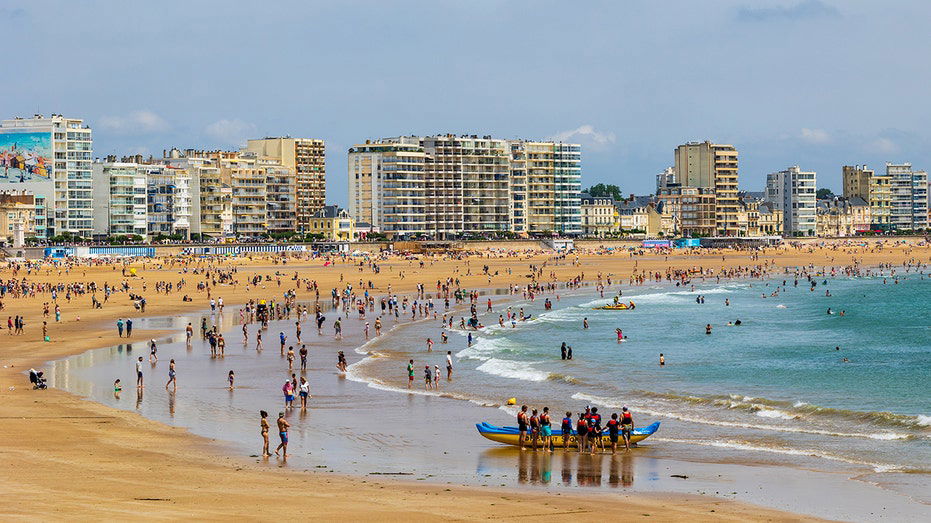- by foxnews
- 30 Jul 2025
How Mexico Unifies with US, Canada, Bahamas, Dominican Republic, Antigua and Barbuda, Argentina in Powering Global Cruise Tourism, Turbocharging Travel Industry, New Update is Here
Cruise tourism in the Americas is entering a powerful new phase, and at the heart of this transformation is a remarkable collaboration among Mexico, the United States, Canada, the Bahamas, the Dominican Republic, Antigua and Barbuda, and Argentina. These nations, once navigating their own cruise strategies, are now forging aligned goals to elevate the industry on a global scale. From investing in state-of-the-art terminals to launching sustainability-driven policies and private cruise destinations, they are turbocharging regional travel growth.
- by travelandtourworld
- 18 Jul 2025
- in travel

Cruise tourism in the Americas is entering a powerful new phase, and at the heart of this transformation is a remarkable collaboration among Mexico, the United States, Canada, the Bahamas, the Dominican Republic, Antigua and Barbuda, and Argentina. These nations, once navigating their own cruise strategies, are now forging aligned goals to elevate the industry on a global scale. From investing in state-of-the-art terminals to launching sustainability-driven policies and private cruise destinations, they are turbocharging regional travel growth.
Cruise tourism is experiencing an extraordinary revival across the Americas, with nations from Canada to Argentina ramping up investments, partnerships, and policies aimed at boosting this lucrative sector. Once reeling from pandemic-induced stagnation, the cruise industry has made an impressive comeback. According to the Cruise Lines International Association (CLIA), North America accounted for over 20 million ocean-going passengers in 2024 alone, nearly 60% of the global cruise total. With Latin American and Caribbean countries experiencing similar momentum, the region is leading a transformative new chapter in global cruise tourism.
North America: Reinventing Cruise Tourism with Scale and Strategy
The U.S. continues to anchor the global cruise industry. In 2024, nearly 19 million Americans embarked on cruise vacations, a 4.5% increase from the previous year. Port cities like Miami, Galveston, and Los Angeles have expanded infrastructure and forged new public-private partnerships to accommodate mega-ships and diversified itineraries.
Canada, though smaller in volume, is showing marked growth. River cruises, Arctic expeditions, and luxury small-ship itineraries are drawing increasing interest. Cities like Vancouver and Montreal are enhancing port connectivity, security protocols, and sustainability measures to handle expanding traffic without sacrificing local charm or ecological balance.
These developments reflect a broader trend: North American cruise tourism is no longer just about Caribbean getaways. From Alaska to the St. Lawrence River, the market is evolving, driven by demand for immersive, curated experiences.
Mexico's cruise tourism sector was valued at over US$200 million in 2024 and is projected to grow at a CAGR of 9.3% through the decade. Port cities like Cozumel, Mahahual, and Puerto Vallarta are popular for their proximity to coral reefs, Mayan ruins, and pristine beaches.
But growth hasn't come without friction. A proposed expansion at Cozumel's SSA Mexico Pier was recently rejected by the island's mayor following community backlash and environmental concerns. It marked a critical pivot: Mexico wants to grow cruise tourism but not at the expense of ecological integrity or public access.
Additionally, the Mexican government has introduced a new per-passenger tax beginning in 2025. The levy starts at $5 and will scale up to $21 per traveler. These funds are earmarked for environmental conservation and infrastructure upgrades, especially in communities that host heavy cruise traffic.
The Caribbean remains the crown jewel of global cruising. In 2024, it accounted for approximately 43% of global cruise itineraries. With crystal-clear waters, year-round tropical weather, and short distances between ports, the region is ideal for both short trips and extended luxury voyages.
The Dominican Republic is not far behind. With over 10 million total tourist arrivals in 2023 (air and sea), the country has expanded its cruise ports in Puerto Plata and La Romana. It offers a unique mix of beach tourism and cultural heritage, supported by government incentives for cruise line collaboration.
Smaller nations like Antigua & Barbuda are also making waves. With 824,000 cruise passengers in 2024, the islands exceeded pre-pandemic records. Strategic marketing, infrastructure development, and blue-economy initiatives are helping these nations compete against cruise giants.
Though still in developmental phases, South American nations are rapidly growing their cruise footprint. Brazil is showing robust demand recovery, driven by domestic travelers and international visitors attracted to Rio, Salvador, and Recife.
Argentina and Chile are becoming hotbeds for expedition cruising. Destinations like Patagonia, Tierra del Fuego, and even Antarctica are drawing affluent travelers interested in unique, high-adventure experiences. As climate awareness grows, these cruises emphasize ecological education and conservation, often in partnership with local NGOs and scientific organizations.
Peru, Colombia, and Uruguay are investing in port modernization, visa facilitation, and new itineraries that link Andean highlands, Amazon river cruises, and coastal exploration. These countries are keen to harness cruise tourism as a vehicle for regional integration and economic uplift.
Several underlying market trends explain the cruise boom in the Americas:
Policy makers across the Americas are playing an increasingly assertive role. From per-passenger taxes in Mexico to sustainability mandates in Canada and zoning restrictions in Cozumel, governments are setting clearer terms for cruise expansion.
At the same time, public sentiment is becoming a decisive force. Local communities are voicing stronger opinions about cruise infrastructure, beach access, and ecological protection. In destinations where tourism represents a double-edged sword, balancing economic gains with community well-being is now a non-negotiable requirement.
Cruise tourism generates billions in revenue and supports millions of jobs across the Americas. It benefits a wide spectrum of sectors, from port logistics and shipbuilding to retail, food services, and entertainment.
But the impact goes beyond economics. Cruises also function as cultural conduits, exposing travelers to indigenous art, regional cuisines, and historic landmarks. When managed responsibly, they can amplify cultural preservation and create platforms for local storytelling.
Yet, the future will depend on stakeholder collaboration. Cruise lines, governments, NGOs, and travelers must co-create policies and products that sustain ecosystems, empower communities, and provide memorable experiences.
New investments must prioritize climate resilience, carbon reduction, and equitable distribution of tourism benefits. As digital tools become more sophisticated, real-time data can guide itinerary adjustments, crowd management, and conservation measures.
From port enhancements in Miami to conservation-centered policies in Cozumel, the Americas are redefining cruise tourism. This transformation is grounded in data, driven by innovation, and framed by a commitment to long-term sustainability.
With the right vision and responsible stewardship, the Americas can not only maintain their lead in cruise tourism but also inspire a global blueprint for what modern, meaningful, and sustainable travel should look like.
But while the numbers looked promising for cruise line profits, the local sentiment told a different story.
The announcement marks a turning point in how island destinations may approach tourism growth. Cozumel chose to prioritize ecological integrity and public consensus over cruise industry pressures. And in doing so, it set an example that is likely to ripple across the Caribbean and beyond.
The decision comes at a time when the cruise industry is aggressively scaling operations to meet pent-up demand following pandemic-era shutdowns. Larger ships, longer itineraries, and deeper port calls are becoming the new normal. Ports worldwide are vying for upgrades to accommodate these behemoths, hoping to secure a share of the rebounding cruise economy.
For cruise lines, the message is clear: future expansion needs to be community-informed, environmentally responsible, and focused on long-term sustainability. The era of unchecked port development may be coming to an end.
Other tourism-dependent regions will be watching closely. The Cozumel case could become the catalyst for a broader movement that forces global travel leaders to innovate, adapt, and listen more carefully.
- by foxnews
- descember 09, 2016
Air travel's 'golden age' featured steak dinners, cocktails and formal attire for sophisticated travelers
Nostalgic reflections about flying as a prestigious luxury with real food served on real plates in decades past are occurring on social media as travel experts weigh in on the experiences.
read more




